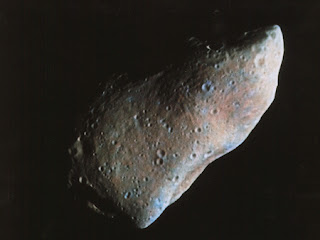 |
| (Stars like our Sun are huge, dynamic, energy-producing concentrations of Hydrogen and Helium, compacted by their enormous gravity into spheres.) |
Whether it is shaping water droplets, stars, soap bubbles or planets, nature seeks to minimize the surface area needed to contain a given volume, and the shape that keeps volume at the absolute minimum a sphere.
Any object in weightless space larger than a couple of hundred miles in diameter has enough mass for its gravity to overcome large-scale irregularities and force it into a spherical shape. The gravitational compression also generates significant amounts of heat at the center of the planet. This heat melts, or at least soften, any solid materials within the planet, facilitating the planet's collapse into a sphere.
Objects in space smaller than about 100 miles in diameter, such as most asteroids, comet nuclei, and small moons, lack the mass to create a gravtational field strength strong enough to compress themselves into spheres. These little spheres are often taken on what I call the 'sick potato' look.
 |
| (The 12.5 miles long, 7.5 mile wide asteroid Gaspra, imaged October 1991 from a distance of 1600 miles by the Galelio spacecraft en route to Jupiter) |
 |
| (The 600 mile-wide asteroid Ceres as seen by the Hubble Space Telescope) |
Pretty much everything in space rotates, and a rotating non-rigid sphere causes it to 'bulge' at its equator from the centrifugal forces acting on it.
This spinning distorted large planets into a slightly squashed shape known as an 'oblate spheroid'. This means that a planet's diameter measured through its poles is smaller than the diameter measured through its equator.
Whereas the difference between the polar diameter and the equatorial diameter of Earth is a barely noticeable 0.3%, the oblateness of Saturn, a large, gaseous and rapidly spinning planet, is greater than 10%. You can easily see Saturn's polar flattening through a telescope.
 |
| (Saturn's polar diameter is 33,700 miles, but its equatorial diameter is 37,360 miles) |
